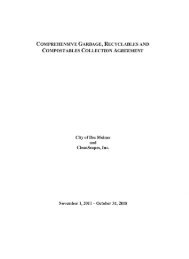CITY OF DES MOINES SHORELINE MASTER PROGRAM
CITY OF DES MOINES SHORELINE MASTER PROGRAM
CITY OF DES MOINES SHORELINE MASTER PROGRAM
Create successful ePaper yourself
Turn your PDF publications into a flip-book with our unique Google optimized e-Paper software.
Des Moines Shoreline Master Program<br />
c. All native trees in the vegetation conservation area over 20 inches in diameter at breast<br />
height shall be retained. Trees determined by the City to be hazardous or diseased may<br />
be removed. Replacement of non-native vegetation with native species shall be done in a<br />
manner that will not leave soil bare or vulnerable to erosion.<br />
d. The Shoreline Administrator may allow removal of vegetation exceeding that described<br />
above where an applicant agrees to replacement plantings that are demonstrated to<br />
provide greater benefit to shoreline ecological functions than would be provided by strict<br />
application of this section, based upon the findings from the 2005 Shoreline Inventory<br />
and Characterization.<br />
6.1.3 Environmental Impact Mitigation<br />
1. All shoreline development and uses shall occur in a manner that results in no net loss of<br />
shoreline ecological functions, through the location and design of all allowed development<br />
and uses. In cases where impacts to shoreline ecological functions from allowed<br />
development and uses are unavoidable, those impacts shall be mitigated, according to the<br />
provisions of this section, to ensure no net loss of shoreline ecological functions.<br />
2. To the extent Washington's State Environmental Policy Act of 1971 (SEPA), Chapter 43.21C<br />
RCW, is applicable, the analysis of environmental impacts from proposed shoreline uses or<br />
developments shall be conducted consistent with the rules implementing SEPA (DMMC<br />
16.04 and WAC 197-11).<br />
3. Where required, mitigation measures shall be applied in the following sequence of steps<br />
listed in order of priority.<br />
a. Avoiding the impact altogether by not taking a certain action or parts of an action;<br />
b. Minimizing impacts by limiting the degree or magnitude of the action and its<br />
implementation by using appropriate technology or by taking affirmative steps to avoid<br />
or reduce impacts;<br />
c. Rectifying the impact by repairing, rehabilitating, or restoring the affected environment;<br />
d. Reducing or eliminating the impact over time by preservation and maintenance<br />
operations;<br />
e. Compensating for the impact by replacing, enhancing, or providing substitute resources<br />
or environments; and<br />
f. Monitoring the impact and the compensation projects and taking appropriate corrective<br />
measures.<br />
4. In determining appropriate mitigation measures applicable to shoreline development, lower<br />
priority measures shall be applied only where higher priority measures are determined to be<br />
infeasible or inapplicable.<br />
5. Required mitigation shall not be in excess of that necessary to assure that proposed uses or<br />
development will result in no net loss of shoreline ecological functions.<br />
6. Mitigation actions shall not have a significant adverse impact on other shoreline functions<br />
fostered by the policies of the Shoreline Management Act.<br />
Department of Ecology approval effective November 1, 2010<br />
Adopted by City of Des Moines Ordinance No. 1502 65



